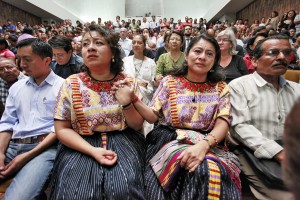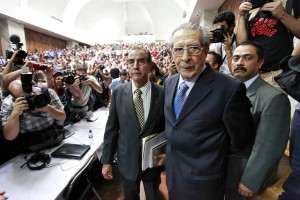Human Rights Column: Guatemala Expects Justice

Members of the Maya community attending the trial. Photo: Daniel Hernández-Salazar / Dictator in the Dock
“This Court, by unanimous resolution declares: that the accused José Efraín Ríos Montt is responsible for the crime of genocide against the lives and integrity of civilians in the villages and hamlets of Santa María Nebaj, San Juan Cotzal and San Gaspar Chajul, and for this crime we impose a prison sentence of 50 years without parole. That the accused José Efraín Ríos Montt is responsible for Crimes Against Humanity…and for this crime we impose a prison sentence of 30 years without parole.”
These words spoken by Judge Yassmín Barrios on May 10, 2013 at the conclusion of the genocide trial of former Guatemala dictator General Efraín Ríos Montt, electrified 400 spectators in the packed courtroom, throwing the room into a tumult. A media frenzy engulfed the defense bench as reporters shoved microphones and cameras at Ríos Montt. Over a hundred Maya Ixil rose up chanting, “justicia, justicia!” Ríos Montt’s lawyers shouted out in protest at the verdict and his supporters booed furiously at the judge. Ríos Montt’s lawyers tried to exit the courtroom with their client, as Judge Barrios, whose microphone had been mysteriously cut off, had to scream to the guards to apprehend Ríos Montt and called for police reinforcements to insure the accused did not escape. The guards did not move to stop Ríos Montt, but the crowd of reporters and spectators now surrounding him made it impossible for him to reach the exit. Judge Barrios, in her high-pitched voice, asked the crowd to settle down, and made clear to Ríos Montt that he was in the custody of the court and had to wait for the police to escort him to prison.
The room settled down in anxious anticipation of the arrival of the police, with a cloud of uncertainty hovering over the murmur of the crowd. A man began quietly to sing a poem by Otto René Castillo: “Here, no one cried / Here, we only want to be human / Eat, laugh, fall in love, live / Live life, not die.” A section of the crowd began to sing along, the song’s haunting words evoking the memory of those who died in Guatemala’s internal armed conflict.
It was overwhelming that after a 30-year quest for justice, Guatemalans had finally achieved this historic accomplishment: it was the first time in 500 years that the genocide of indigenous peoples had been put on trial anywhere in North or South America, and it was the first time anywhere in the world that a former head of state had been tried and convicted of genocide in a national justice system. Living this historic moment with us were many of the protagonists whose struggle for justice was chronicled in our film Granito: How to Nail a Dictator: Rigoberta Menchú, Antonio Caba, Kate Doyle, Pancho Soto, Fredy Peccerelli, Naomi Roht-Arriaza, and Almudena Bernabeu. A seemingly interminable hour passed before the police finally arrived, and Ríos Montt was taken to prison–the justice system had triumphed in the battle against impunity!
But that victory would prove to be short lived. Ten days after the guilty verdict was handed down, the trial was suspended and the verdict was vacated in a controversial 3/2 split decision by the Constitutional Court (Guatemala’s highest court), leaving the trial in a unique state of limbo, and General Ríos Montt remains under house arrest. Yet it is unclear when the trial will resume.
It is widely held in Guatemala that the Constitutional Court’s decision was influenced by tremendous pressure exerted by Guatemala’s powerful business and political elite, embodied by their organization CACIF (Coordinating Committee of Agricultural, Commercial, Industrial, and Financial Associations). Immediately after the verdict they unleashed a ferocious media juggernaut pounding out the message that there had never been genocide in Guatemala, that Guatemala could not be stigmatized as a genocidal country, and that Ríos Montt was the victim of political persecution and “international enemies.” In press conferences they called stridently for the verdict to be overturned, that it was an offense to Guatemala and would trigger dire economic consequences. Adding fuel to the fire, President Otto Pérez Molina, a former military officer in the Maya Ixil region during the time covered in the case (1982-83), also publicly announced that there had never been genocide in Guatemala.
Why was this case different from other recent trials in Guatemala, where former military and police have been found guilty of atrocities committed during the armed conflict, and their prison sentences upheld? The answer is it was a genocide case, with all the stigma and legal ramifications that brings upon the perpetrators. Members of CACIF had provided financial and logistical support to the military during the regime of Ríos Montt, and Zuri Ríos, the general’s daughter and his staunchest defender, assured the CACIF that if her father went down they would be next in the sights of Guatemalan Attorney General Claudia Paz y Paz.
The decision by the Constitutional Court and the public pronouncements of the CACIF exposed a stark fissure in the Guatemalan justice system, in their attacks on the integrity of Attorney General Claudia Paz y Paz and Judge Yassmín Barrios for giving victims their long sought access to justice, and pushing back on the entrenched impunity that has reigned for so long.

Members of the Maya community attending the trial. Photo: Daniel Hernández-Salazar / Dictator in the Dock
But the Maya Ixil plaintiffs and Guatemalan human rights organizations that represent them like CALDH (Center for Human Rights Legal Action), consider the Constitutional Court decision to be illegal. They point out that vacating the verdict was done on procedural rather than evidentiary grounds, because the evidence presented by the prosecution was overwhelming. They see it as an unsurprising exercise of impunity. To counter it they have published hundreds of copies of the 700-page sentence, in which all the evidence presented in the case is laid out, and are distributing them throughout the Maya Ixil region. The verdict may have been vacated, but the sentencing document and the evidence remain in the public realm. CALDH and the Association for Justice and Reconciliation, the organization led by the victims, have decided on their next move: they are taking the Ríos Montt case to the Inter-American Court of Human Rights. Stay tuned.
To see highlights from the trial we invite you to watch select episodes from Skylight’s “Dictator in the Dock” series at: http://skylight.is/films/dictator-in-the-dock/
To learn more about the relationship between CACIF and the Guatemalan military during the armed conflict, read this excellent investigative piece from Guatemalan online news site Plaza Pública (in Spanish only): http://tinyurl.com/jvvec5k
Also available: day-to-day trial blogs at the Open Society Justice Initiative’s trial site: http://www.riosmontt-trial.org/
Filmmakers Pamela Yates and Paco de Onís described the search for justice in Guatemala in their award-winning documentary, Granito: How to Nail a Dictator.













